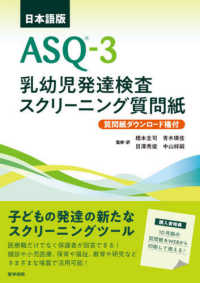Full Description
Math is not rote-memorizable. Math is not random-guessable. Math is figure-out-able.
Author Pam Harris argues that teaching real math—math that is free of distortions—will reach more students more effectively and result in deeper understanding and longer retention. This book is about teaching undistorted math using the kinds of mental reasoning that mathematicians do.
Memorization tricks and algorithms meant to make math "easier" are full of traps that sacrifice long-term student growth for short-lived gains. Students and teachers alike have been led to believe that they've learned more and more math, but in reality their brains never get any stronger. Using these tricks may make facts easier to memorize in isolation, but that very disconnect distorts the reality of math.
In her landmark book Developing Mathematical Reasoning: Avoiding the Trap of Algorithms, Pam emphasizes the importance of teaching students increasingly sophisticated mathematical reasoning and understanding underlying concepts rather than relying on a set rule for solving problems. Now, in this first companion volume, Developing Mathematical Reasoning: The Strategies, Models, and Lessons to Teach the Big Ideas in Grades K-2, she demonstrates how counting and additive strategies serve as the foundation for creating efficient, accurate, and flexible thinkers.
Everyone is capable of understanding and doing real math. This book:
Gives step-by-step guidance on how to teach the strategies, models, and big ideas that foster confidence and long-term success, preparing students for increasingly complex mathematical challenges
Offers the "what to do" to teach counting, addition, and subtraction in ways that promote reasoning over rote memorization
Provides practical tools such as problem strings, models, classroom routines, and discussion questions designed to implement reasoning-based practices
Includes supporting resources for creating a classroom culture where students see math as figure-out-able and gain confidence as mathematical thinkers
By addressing common misconceptions about math and providing practical strategies for teaching real math, this book shows that everyone can use the mathematical relationships they already know to reason about new relationships. In other words, everyone can math-even the very youngest students!
Contents
Preface
About This Book
Language Use in This Book
Acknowledgments
About the Author
PART I: SETTING THE STAGE
Chapter 1: MATHEMATICS FOR TEACHING
What's the Purpose of Learning Math?
The Development of Mathematical Reasoning
Major Strategies
Conclusion
Discussion Questions
PART II: DEVELOPING COUNTING AND COUNTING STRATEGIES
Chapter 2: ALL ABOUT COUNTING
The Difference Between Counting and Counting Strategies
Foundations of Number
How to Develop Counting
The Number Sequence in the Teens
The Number Sequence After the Teens
Meaning of Decades
Student Interview
Conclusion
Discussion Questions
Chapter 3: COUNTING STRATEGIES
About Counting Strategies
Early Counting Strategies
The Counting On, Counting Back Strategy
Problem Types
Developing Counting Strategies
Conclusion
Discussion Questions
PART III: DEVELOPING ADDITIVE REASONING
Chapter 4: THE MAJOR STRATEGIES FOR ADDITION WITHIN 20
Additive Reasoning
Additive Strategies
Developing Addition Within 20
The Get to 10 Strategy
The Next Two Major Strategies
The Using Doubles to Add Strategy
The Add 10 and Adjust Strategy
Comparing the Single-Digit Addition Strategies
Conclusion
Discussion Questions
Chapter 5: THE MAJOR STRATEGIES FOR SUBTRACTION WITHIN 20
Developing Subtraction Within 20
The Remove to 10 Strategy
The Next Two Major Strategies
The Using Doubles to Subtract Strategy
The Remove 10 and Adjust Strategy
Finding the Distance/Difference Strategy
Comparing the Single-Digit Subtraction Strategies
Conclusion
Discussion Questions
Chapter 6: THE MAJOR STRATEGIES FOR DOUBLE-DIGIT ADDITION
Developing Multi-Digit Addition Strategies
The Splitting by Place Value Strategy
The Next Two Major Strategies
The Add a Friendly Number Strategy
The Get to a Friendly Number Strategy
The Add a Friendly Number Over Strategy
The Give and Take Strategy
Comparing the Major Addition Strategies
Conclusion
Discussion Questions
Chapter 7: THE MAJOR STRATEGIES FOR MULTI-DIGIT SUBTRACTION
Developing Multi-Digit Subtraction Strategies
The Remove by Place Value Strategy
The Next Two Major Strategies
The Remove a Friendly Number Strategy
The Remove to a Friendly Number Strategy
The Remove a Friendly Number Over Strategy
Finding the Distance/Difference Strategy
The Constant Difference Strategy
Comparing the Major Strategies for Multi-Digit Subtraction
Conclusion
Discussion Questions
PART IV: PUTTING IT ALL TOGETHER
Chapter 8: TASKS TO DEVELOP MATHEMATICAL REASONING
Sequencing Tasks
Problem Strings
Other Instructional Routines
Games
Hint Cards
Conclusion
Discussion Questions
Chapter 9: MODELING AND MODELS
Strategies Versus Models
The Many Meanings of Model
Exploring Models by Their Best Uses
Our Modeling Framework
Conclusion
Discussion Questions
Chapter 10: MOVING FORWARD
Mentor Mathematicians
Where to Start
Conclusion
Discussion Questions
References
Index







